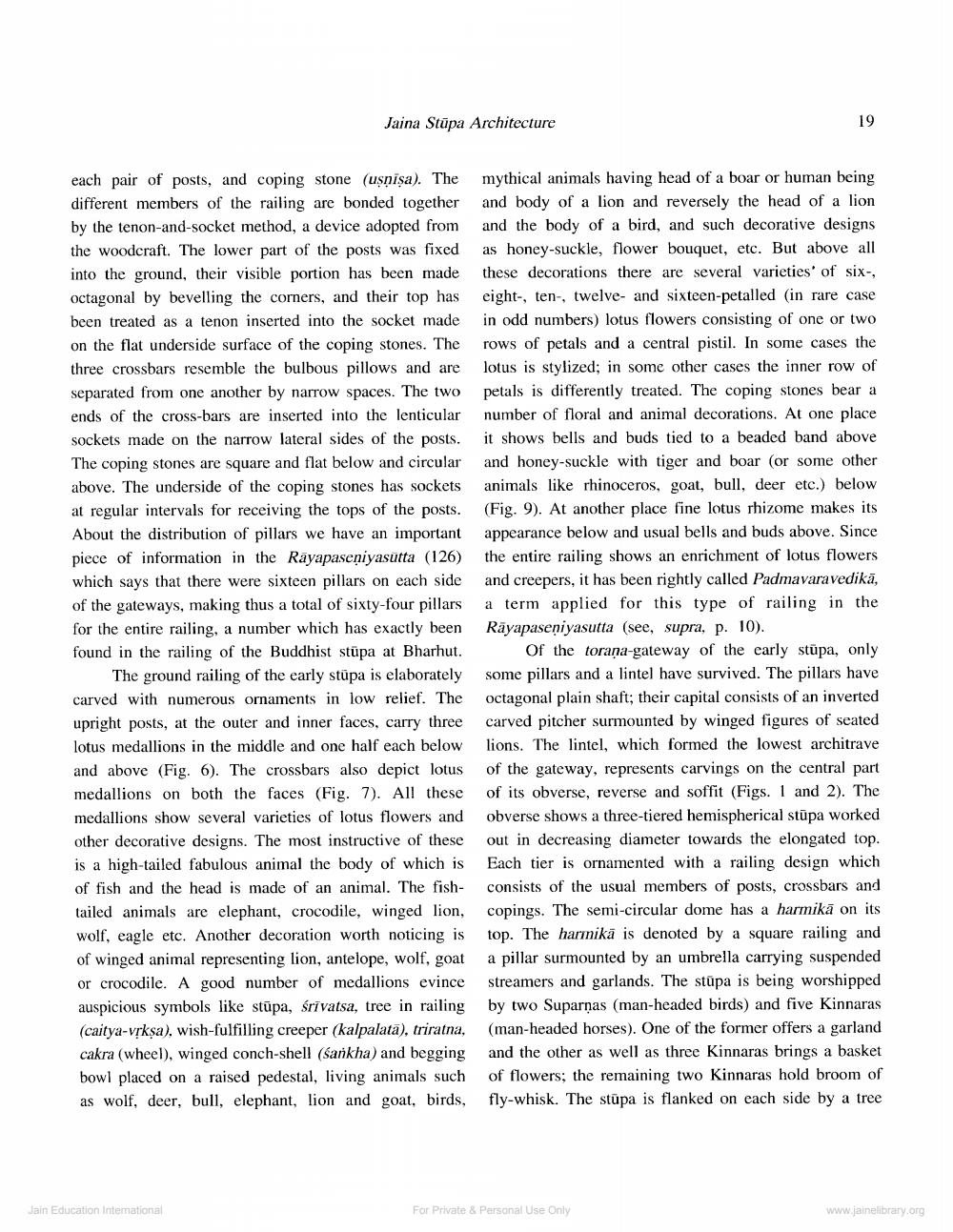________________
Jaina Stūpa Architecture
19
each pair of posts, and coping stone (usnisa). The different members of the railing are bonded together by the tenon-and-socket method, a device adopted from the woodcraft. The lower part of the posts was fixed into the ground, their visible portion has been made octagonal by bevelling the corners, and their top has been treated as a tenon inserted into the socket made on the flat underside surface of the coping stones. The three crossbars resemble the bulbous pillows and are separated from one another by narrow spaces. The two ends of the cross-bars are inserted into the lenticular sockets made on the narrow lateral sides of the posts. The coping stones are square and flat below and circular above. The underside of the coping stones has sockets at regular intervals for receiving the tops of the posts. About the distribution of pillars we have an important piece of information in the Rayapaseņiyasutta (126) which says that there were sixteen pillars on each side of the gateways, making thus a total of sixty-four pillars for the entire railing, a number which has exactly been found in the railing of the Buddhist stūpa at Bharhut.
The ground railing of the early stūpa is elaborately carved with numerous ornaments in low relief. The upright posts, at the outer and inner faces, carry three lotus medallions in the middle and one half each below and above (Fig. 6). The crossbars also depict lotus medallions on both the faces (Fig. 7). All these medallions show several varieties of lotus flowers and other decorative designs. The most instructive of these is a high-tailed fabulous animal the body of which is of fish and the head is made of an animal. The fish- tailed animals are elephant, crocodile, winged lion, wolf, eagle etc. Another decoration worth noticing is of winged animal representing lion, antelope, wolf, goat or crocodile. A good number of medallions evince auspicious symbols like stūpa, srivatsa, tree in railing (caitya-vřkşa), wish-fulfilling creeper (kalpalatā), triratna, cakra (wheel), winged conch-shell (sarkha) and begging bowl placed on a raised pedestal, living animals such as wolf, deer, bull, elephant, lion and goat, birds,
mythical animals having head of a boar or human being and body of a lion and reversely the head of a lion and the body of a bird, and such decorative designs as honey-suckle, flower bouquet, etc. But above all these decorations there are several varieties of six-, eight-, ten-, twelve- and sixteen-petalled in rare case in odd numbers) lotus flowers consisting of one or two rows of petals and a central pistil. In some cases the lotus is stylized; in some other cases the inner row of petals is differently treated. The coping stones bear a number of floral and animal decorations. At one place it shows bells and buds tied to a beaded band above and honey-suckle with tiger and boar (or some other animals like rhinoceros, goat, bull, deer etc.) below (Fig. 9). At another place fine lotus rhizome makes its appearance below and usual bells and buds above. Since the entire railing shows an enrichment of lotus flowers and creepers, it has been rightly called Padmavaravedikā, a term applied for this type of railing in the Rayapaseniyasutta (see, supra, p. 10).
Of the torana-gateway of the early stūpa, only some pillars and a lintel have survived. The pillars have octagonal plain shaft; their capital consists of an inverted carved pitcher surmounted by winged figures of seated lions. The lintel, which formed the lowest architrave of the gateway, represents carvings on the central part of its obverse, reverse and soffit (Figs. 1 and 2). The obverse shows a three-tiered hemispherical stūpa worked out in decreasing diameter towards the elongated top. Each tier is ornamented with a railing design which consists of the usual members of posts, crossbars and copings. The semi-circular dome has a harmikā on its top. The harmikā is denoted by a square railing and a pillar surmounted by an umbrella carrying suspended streamers and garlands. The stūpa is being worshipped by two Suparnas (man-headed birds) and five Kinnaras (man-headed horses). One of the former offers a garland and the other as well as three Kinnaras brings a basket of flowers, the remaining two Kinnaras hold broom of fly-whisk. The stūpa is flanked on each side by a tree
Jain Education Intemational
For Private & Personal Use Only
www.jainelibrary.org




